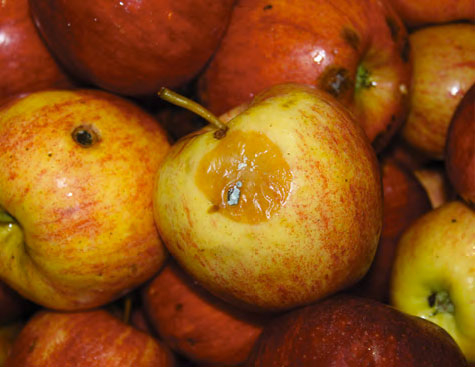Crop protection does not end at picking. The fruit continues to be at risk of infection and breakdown throughout harvest, storage, packing and during marketing (postharvest supply chain).
Many postharvest rots start during flowering and fruit growth in the orchard but the decay is only seen after harvest. Therefore, maintaining good crop protection measures in the orchard is critical.
Fungal infections
Fungal infections are the main pathological diseases in temperate fruit and these can cause large postharvest losses during storage.
Numerous pre and postharvest factors interact to influence the incidence of postharvest decay, including the fungal spore load in the orchard or packing shed, fruit nutritional status, maturity and type of calyx of the apple.
For example, apple varieties with open calyxes (i.e. open between the external calyx and the core) are more prone to rots such as mouldy core or core rot, which can enter via the calyx during postharvest handling.
Common postharvest fungal diseases and their pathogens of temperate fruit in NSW include brown rot, alternaria rot, blue mould, grey mould, anthracnose, target rot/spot, mucor rot, ripe fruit spot and transit rot.
Blue mould
Blue mould is the most common and important postharvest disease. It is caused primarily by the fungus Penicillium expansum.
Grey mould
Grey mould, caused by Botrytis cinerea is the most frequently encountered disease in untreated fruit stored in bins. Because B. cinerea frequently spreads from fruit to fruit, losses from an initial infection can be large.
Anthracnose
Anthracnose rots have been called ripe fruit rot, lenticel rot, target rot or spot, and bitter rot and are primarily caused by the related fungi Phlyctaema vagabunda, Cryptosporiopsis malicorticis and Colletotrichum gloeosporioides. Infection occurs during fruit growth and remains dormant but can develop when the fruit becomes less resistant to disease during ripening.
Preharvest disease management
Controlling postharvest diseases begins with good crop protection and general orchard hygiene throughout the growing season.
This ensures that the fruit is as clean as possible when harvested, thus minimising postharvest decay during storage.
Diseases associated with postharvest decay can be controlled in the field, and some fungicide-based orchard sprays can be applied leading up to and just before harvest for certain diseases. Late season sprays can also help to ensure fruit enters the storage and processing chain with reduced spore loads and lower potential for infection and breakdown. Check individual product labels for registered crops, diseases and harvest withholding periods.
Fruit susceptibility
The susceptibility of the fruit tissue to fungal attack is influenced by fruit maturity, nutritional status and the spore load in the packing house.
Therefore, fruit should be harvested at optimum maturity and always handled carefully to prevent creating injury points for infection, such as puncture marks or fruit bruising.
Fruit injury sites are ideal entry points to fungal spores such as Penicillium and Mucor species.
Download the Orchard plant protection guide
See this article in Tree Fruit April 2022




















